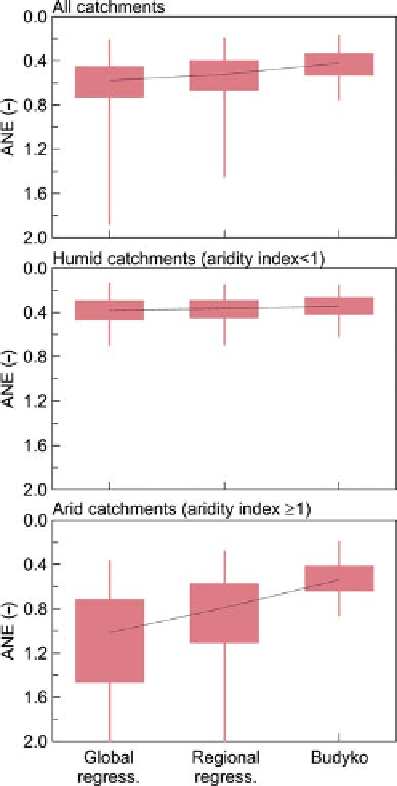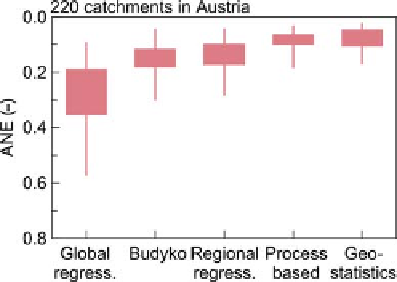Geography Reference
In-Depth Information
Figure 5.30. Absolute normalised error (ANE) of mean annual runoff
estimated by global regression, Budyko model, regional regression
(fitted to Austrian data), process-based (conceptual hydrological
model) and geostatistical (top-kriging) approach in 209 humid
catchments in Austria.
5.6 Summary of key points
Annual runoff variability reflects, and is governed by,
the relative availability of water (annual precipitation)
and energy (expressed in terms of the annual potential
evaporation). Consequently, the aridity index (the ratio
of potential evaporation to precipitation) is the most
widely used similarity measure for annual runoff.
Increasingly, traditional interpolated spatial maps of
mean annual runoff are being replaced with predictions
based on regressions with climate and catchment attri-
butes (as predictors and as surrogates for runoff pro-
cesses), geostatistical interpolations in data-rich regions,
and the application of index-based methods that exploit
the competition between water and energy (e.g., Budyko
curve and related methods).
Figure 5.29. Absolute normalised error (ANE) of predicting mean
annual runoff in ungauged basins for different regionalisation
methods, stratified by aridity. (Top) All catchments; (centre) humid
catchments (aridity index
Budyko-type methods have the advantage that they
reflect the co-variation of climate, catchment properties
(including vegetation) and runoff, and exploit their inter-
relationships in a holistic way. Another advantage of
Budyko-type methods is that they exemplify the benefits
of a comparative hydrology approach, learning from
similarities and differences between different places.
<
1); (bottom) arid catchments (aridity
index
1). Lines connect median efficiencies for the same study.
Boxes are 40%
≥
-
60% quantiles, whiskers are 20%
-
80% quantiles.
The Budyko approach tends to underestimate mean
annual runoff. The regression models tend to overesti-
mate runoff in arid catchments.
Under humid, arid and cold climate conditions, catch-
ment area, mean annual temperature and mean annual
precipitation are important predictors for mean annual
runoff in the regression approach (with the exception of
tropical climates where mean annual temperature does
not have much predictive power). This reflects the
capacity of these predictors to capture the combined
effects of several process controls on annual runoff.
Co-evolutionary indices that are reflective of annual
runoff variability are drainage density and vegetation
patterns (fraction of vegetation cover, as well as relative
fractions of deep-rooted trees and shrubs).
In humid catchments, the Budyko approach and regres-
sion methods perform similarly.
In arid catchments, the Budyko approach performs
much better than the regression methods. Regional
regressions perform better than global regression.
In a regional case study, the performance of predicting
mean annual runoff in ungauged basins for different
methods increases in the following order: global regres-
sion, Budyko model, regional regression, process-based
method and geostatistical approach.


Search WWH ::

Custom Search